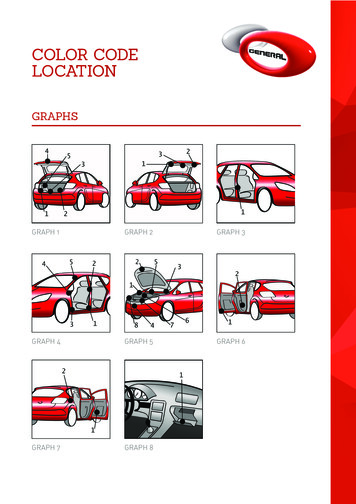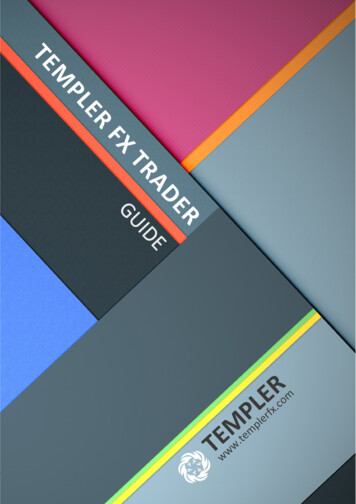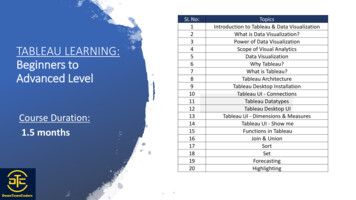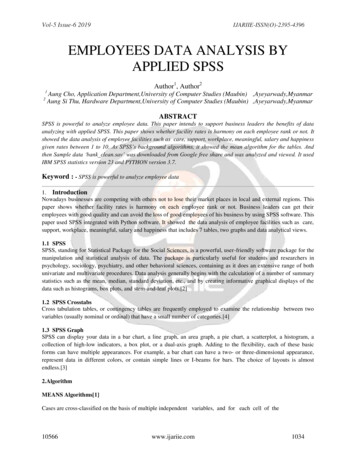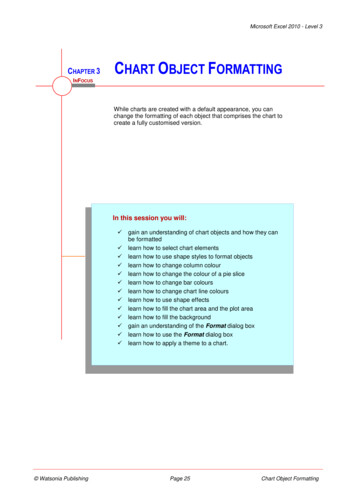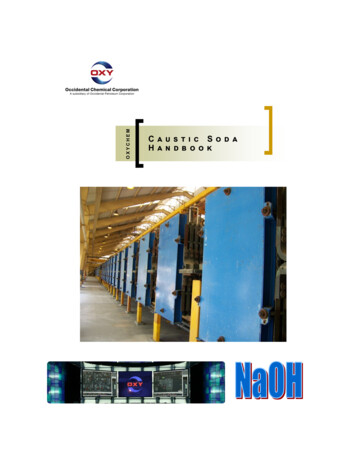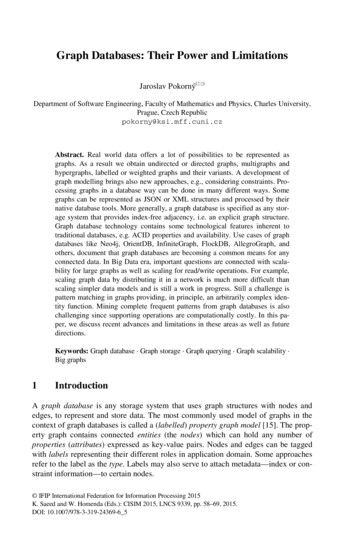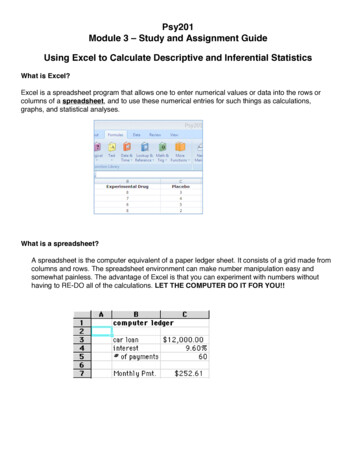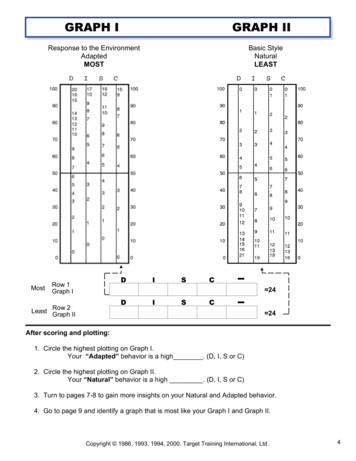
Transcription
GRAPH IGRAPH IIResponse to the EnvironmentAdaptedMOSTMostDRow 1Graph IBasic StyleNaturalLEASTISC 24DRow 2LeastGraph IIISC 24After scoring and plotting:1. Circle the highest plotting on Graph I.Your “Adapted” behavior is a high . (D, I, S or C)2. Circle the highest plotting on Graph II.Your “Natural” behavior is a high . (D, I, S or C)3. Turn to pages 7-8 to gain more insights on your Natural and Adapted behavior.4. Go to page 9 and identify a graph that is most like your Graph I and Graph II.Copyright 1986, 1993, 1994, 2000. Target Training International, Ltd.4
UNDERSTANDING THE GRAPHSGraph IResponse to the EnvironmentAdapted Behaviorm Graph I is generated from your “Most” responsesYour “Most” responses illustrate the behavior you exhibit in your “focus” environment.m Graph I is your “mask” graphWe tend to adapt our behavior to meet the demands of our environment. Graph I representsthe behavior you project to others. It may not be the same as your natural behavior.m Graph I is the most changeableGraph I can change depending on the demands from your environment. Many times successcan be directly related to your ability to read an environment and adapt the correct behavior towin.m Graph I is your “focus” graphGraph I illustrates the behavior in your “focus” environment. It may change between work andhome or can be situational. For example, meetings tend to demand certain types of behaviordepending on your role, which may not be the same as your Basic (Natural) Style.Graph IIBasic StyleNatural Behaviorm Graph II is generated from your “Least” responsesWhen you select adjectives that are “Least” like you, the system moves you away from thattype of behavior. For example, if you select words that describe you least, such as bold,daring or determined, your plot point on that factor will move down. Identifying what you are“least” like allows the process to determine your natural behavior.m Graph II is your natural behaviorWhen you are under pressure, your behavior will reflect your natural style because you do nothave the energy to adapt or mask your behavior. Also, when you are totally at ease and haveno need to adapt, others will see your natural behavior.m Graph II is the least changeableGraph II will seldom change significantly because this represents the “real” you.m Graph II can change if you experience a significant emotional event.A significant emotional event can cause change in Graph II. For example, divorce, death of aloved one or loss of employment can significantly impact a person’s emotions and changeGraph II.5Copyright 1986, 1993, 1994, 2000. Target Training International, Ltd.
HISTORY OF THE DISC LANGUAGEAs early as 400 B.C., Hippocrates observed similarities and differences in human behavior andclassified four different behaviors. In 1921, C.G. Jung spoke of four “types” oriented by fourpsychological functions: thinking, feeling, sensation and intuition. He then further divided the types into“introversion” and “extroversion.”The Personal Insights Profile uses the Style Analysis Instrument which is based on the work of Dr.William Moulton Marston. Born in Cliftondale, Massachusetts, in 1893, Dr. Marston was educated atHarvard University. He received three degrees from that institution, an A.B. in 1915, a LL.B in 1918 anda Ph.D. in 1921.Most of Dr. Marston’s adult life was spent as a teaching and consulting psychologist. Some of hisassignments included lecturing at the American University, Tufts, Columbia and New York University. Aprolific writer, Dr. Marston was a contributor to the American Journal of Psychology, the EncyclopediaBritannica, and the Encyclopedia of Psychology, all while authoring and/or coauthoring five books.Although still a consulting psychologist, Marston was most active in the last five years of his life as theoriginator, writer and producer of “Wonder Woman”, a successful comic strip which first appeared inbook form. In this endeavor, he used the pen name Charles Moulton. Stricken with Poliomyelitis in1944, Dr. Marston was partially paralyzed from that time until his death at age 53 in 1947.In 1928 he published a book, “The Emotions of Normal People,” in which he described the theory weuse today. He viewed people as behaving along two axes with their actions tending to be active orpassive depending upon the individual’s perception of the environment as either antagonistic orfavorable.By playing these axes at right angles, four quadrants were formed, each circumscribing a behavioralpattern.(1) Dominance produces activity in an antagonistic environment.(2) Inducement produces activity in a favorable environment (called influence in this system).(3) Steadiness produces passivity in a favorable environment.(4) Compliance produces passivity in an antagonistic environment.Dr. Marston believed that people tend to learn a self-concept which is basically in accord with one ofthe four factors. It is possible, therefore, using Marston’s theory, to apply the powers of scientificobservation to behavior and to be Objective and Descriptive rather than Subjective and Judgmental.How you respond to problems or challenges.How you influence others to your point of view.S - Steadiness - ConsistencyHow you respond to the pace of the environment.C - Compliance - ConstraintsHow you respond to rules and procedures set by others.“All people exhibit all four behavioral factors in varyingdegrees of intensity.”—W.M. MarstonC DS IEXTROVERTEDACTIVEI - Influence - ContactsINTROVERTEDPASSIVED - Dominance - ChallengeBEHAVIORAL RELATIONSCopyright 1986, 1993, 1994, 2000. Target Training International, Ltd.6
GENERAL cientiousCourteousDiplomaticFact-finderHigh riendlyGood ListenerPatientRelaxedSincereStableSteadyTeam PlayerUnderstandingVALUE TO THE TEAM:§ Maintains high standards§ Conscientious and steady§ Defines, clarifies, gets informationand tests§ Objective - “The anchor of reality”§ Comprehensive problem solverTENDENCY UNDER STRESS:§§§§PessimisticPickyFussyOverly CriticalIDEAL ENVIRONMENT:§§§§§Where critical thinking is neededTechnical work or specialized areaClose relationship with small groupFamiliar work environmentPrivate office or work areaPOSSIBLE LIMITATIONS:§§§§Be defensive when criticizedGet bogged down in detailsBe overly intense for the situationAppear somewhat aloof and coolEMOTION OF THE HIGH C:FearVALUE TO THE TEAM:§§§§§Dependable team playerWork for a leader and a causePatient and empatheticLogical step-wise thinkerService-orientedTENDENCY UNDER tInflexibleIDEAL ENVIRONMENT:§§§§§Where critical thinking is neededTechnical work or specialized areaClose relationship with small groupFamiliar work environmentPrivate office or work areaPOSSIBLE LIMITATIONS:§§§§Yield to avoid controversyDifficulty in establishing prioritiesDislike of unwarranted changeDifficulty dealing with diversesituationsEMOTION OF THE HIGH S:Unemotional7Copyright 1986, 1993, 1994, 2000. Target Training International, Ltd.
GENERAL veDaringDecisiveDirectInnovativePersistentProblem SolverResults-orientedSelf-starterVALUE TO THE TEAM:§§§§§Bottom line s activityInnovativeTENDENCY UNDER IDEAL ENVIRONMENT:§ Freedom from controls, supervisionand details§ An innovative and futuristic-orientedenvironment§ Forum to express ideas andviewpoints§ Non-routine work§ Work with challenge and opportunityPOSSIBLE LIMITATIONS:§§§§Overuse of positionSet standards too highLack tact and diplomacyTake on too much, too soon, toofastEMOTION OF THE HIGH bleTrustingVALUE TO THE TEAM:§§§§§Optimism and enthusiasmCreative problem solvingMotivates others toward goalsTeam playerNegotiates conflictsTENDENCY UNDER STRESS:§§§§Self-promotingOverly optimisticGabbyUnrealisticIDEAL ENVIRONMENT:High degree of people contactFreedom from control and detailFreedom from movementForum for ideas to be heardDemocratic supervisor with whomhe can associate§§§§§POSSIBLE LIMITATIONS:§§§§Inattentive to detailsBe unrealistic in appraising peopleTrust people indiscriminatelySituational listenerEMOTION OF THE HIGH I:OptimismCopyright 1986, 1993, 1994, 2000. Target Training International, Ltd.8
INSIGHTS TO YOUR PERSONAL BEHAVIORThis page identifies the most common (DISC) graphs. First locate the Graph that is most similar to yourGraph I, then repeat for graph II. My Graph I is most like . My Graph II is most like .Pages 11-18 will provide more information to help you further understand your Adapted and Naturalstyle.CS9DD I S CD I S CD I S CImplementor #24Conductor #1Persuader #12Implementor #9D I S CD I S CD I S CD I S CD I S CAnalyzer #55Analyzer #38Conductor #57Conductor #27Conductor #42D I S CD I S CD I S CD I S CD I S CD I S CAnalyzer #7Coordinator #21D I S CAnalyzer #60ID I S CD I S CD I S CSupporter #5Coordinator #20Relater #17Promoter #3Persuader #13Relater #16D I S CD I S CD I S CD I S CD I S CD I S CSupporter #59Supporter #35Supporter #50Promoter #58Promoter #47Promoter #30Copyright 1986, 1993, 1994, 2000. Target Training International, Ltd.
THE SUCCESS INSIGHTS WHEEL The Success Insights Wheel was developed to give you a visual representation of your Natural and Adapted Styles. Referto page 9 to identify which section of the wheel represents your Graph I and which section of the wheel represents yourGraph II. Draw an asterisk (*) in the correct section from your Graph I. Draw a circle ( ) in the section that represents yourGraph atingPreciseAccurateQuality-OrientedCritical ListenerAttention to Detail247LogicalProduct-OrientedSlow to 4260 5712759 5847 3035 ntedChange Agent1213PersuasiveProcess-OrientedQuick to ChangeIndependentOptimistic3Good SupporterTeam PlayerPersistentCooperativeSensitive to onfidentWORK ENVIRONMENTIf your job could talk, what would it say? Based on the descriptors around the wheel, place a (J) in the section of the wheelthat best describes your job. How does it compare with your Graph I and Graph II locations?High Quality StandardsProcedures to FollowAccuracyAnalysis of Facts and DataCreative and Original ThinkingLogical DecisionsStudying and Solving ProblemsEffective Time-ManagementBold, Aggressive ActionsChallenging AssignmentsAuthorityFirm, Quick Decision MakingTask-OrientationAdherence to StandardsGuidelines to FollowDiplomacy and CooperationChange AgentEnthusiasmResults Through PeopleTesting of New IdeasLogical ThinkingSystematic RoutineRelaxed PaceTeam ParticipationPeople ContactVerbalizes Thoughts and IdeasVaried ActivitiesMobilityCoachingTeamworkService to OthersHarmonious Work EnvironmentCopyright 1986, 1993, 1994, 2000. Target Training International, Ltd.10
HIGH C BEHAVIORAL GRAPHSKEY STRENGTHSq Ability to do tough assignments rightthe first timeAnalyzer #7D I S CTENDENCIESGoal: Accuracy and qualityq Alert and sensitive to errors whereprecision and accuracy are requiredJudges others by: Correct results,proof and facts presentedq Professional and disciplined in theirapproach as it relates to an area oftheir expertiseInfluences others by: Use of data andexactnessValue to the organization: Highstandards for self and subordinates,well-disciplinedq Organization skills, wise use of timeIMPROVE EFFECTIVENESS BYq Being less of a perfectionistOveruses: Rules and regulationsq Going “by the book” less oftenWhen under stress: Becomesoverly critical of self and othersq More enthusiasm, less reliance ondataKEY STRENGTHSq Ability to set and accomplish highstandards of conduct and workFears: High-risk decisionsCoordinator #21D I S CTENDENCIESGoal: Security and neatnessJudges others by: Precise standardsq Alert and sensitive to problems, rules,errors and proceduresInfluences others by: Dependability,attention to detailq Ability to make tough decisionswithout letting emotions interfereValue to the organization:Conscientiousness, maintains standardsq Ability to understand and preserve theneed for quality systemsOveruses: Dependency on standardoperating procedureIMPROVE EFFECTIVENESS BYq Stating true feelings on issuesq Less concern that change maydamage relationships or qualityWhen under stress: Becomesintroverted, obstinateq More confidence, interdependencyFears: AntagonismKEY STRENGTHSq Ability to do quality work whileexploring new ways to increasequantityq Ability to make tough decisions, usinginsight and facts, while remainingunemotionalq Ability to push hard to discover correctacceptable solutions to problemsq Expects and challenges team tohigher performance standardsIMPROVE EFFECTIVENESS BYq Being sensitive to the feelings ofothersImplementor #24D I S CTENDENCIESGoal: Designing systemsJudges others by: Their own highstandardsInfluences others by: Setting a pace indeveloping systemsValue to the organization: Precise,conscientious workerOveruses: Facts and figuresWhen under stress: Takes on too muchFears: Disorganizationq Being less blunt and directq Showing more sincerity11Copyright 1986, 1993, 1994, 2000. Target Training International, Ltd.
HIGH C BEHAVIORAL GRAPHSKEY STRENGTHSq A promoter of quality systemsAnalyzer #60D I S Cq A good sense of urgency balanced withmaintaining high standardsTENDENCIESGoal: DiplomaticJudges others by: Who they know,prestige and accomplishmentsq Organized, even in relationships.Appreciates company of people withsimilar ideas, likes being organized andquality-consciousInfluences others by: Strategy in goodrelationsValue to the organization: Creates agood working environmentq Sensitive to change in the social andwork environmentOveruses: TactfulnessIMPROVE EFFECTIVENESS BYq Being more accepting of others’ ideasand beliefsWhen under stress: Becomes too suaveFears: Having to trade quality for goodrelationshipsq Setting realistic goalsq Not being overly sensitive to otherpeople’s commentsKEY STRENGTHSq Willing to adapt and be an integral partof the team—unless adapting lowersqualityAnalyzer #55D I S CTENDENCIESGoal: Technical abilityJudges others by: Their skills andexpertiseq Ability to see both the good and the badin any situationInfluences others by: Being levelheadedq Ability to get results through people andcomplete tasks with high standardsValue to the organization: Combinedtask and people skillsq Places a high priority on conservingresourcesOveruses: High standardsWhen under stress: Becomes uneasy,unpleasantIMPROVE EFFECTIVENESS BYq Being realistic when appraising peopleFears: Lack of recognitionq Making quicker decisions even whenmore data relating to quality is neededq Respecting others’ efforts and valuingteam membersKEY STRENGTHSq Ability to fight hard for results and/orprocedures to ensure quality andcorrectnessq Ability to ask the right questions touncover hidden factsq Avoids favoritism when evaluatingpersonnelq Will combine analytical and intuitiveskills when dealing with complex issuesIMPROVE EFFECTIVENESS BYq Being less analytical in trying to achievecorrectnessq Not hiding emotion and expressing morethoughts to othersAnalyzer #38D I S CTENDENCIESGoal: Problem solverJudges others by: Their use of dataInfluences others by: Facts and figuresValue to the organization: Independentlyaccepts analytically challengingassignmentsOveruses: PerfectionismWhen under stress: Becomes bluntFears: People contact, high risks and lackof privacyq Sharing information, team cooperationCopyright 1986, 1993, 1994, 2000. Target Training International, Ltd.12
HIGH D BEHAVIORAL GRAPHSKEY STRENGTHSq Ability to tackle tough problems dealingwith many issuesConductor #1D I S CTENDENCIESGoal: Dominance and independenceq Forward-looking, aggressive andcompetitiveJudges others by: Their ability forgetting the task done quicklyq Ability to work in an environment thathas variety and changeInfluences others by: Force ofcharacter, persistenceq Initiates activity and sets a pace toachieve desired resultsValue to the organization: Show ‘emattitudeIMPROVE EFFECTIVENESS BYq Being less intense, opinionated andbluntOveruses: Challenge and contestWhen under stress: Becomes quiet andanalyticalq Not coercing others who may not be ascommitted to a project as they areFears: Losing controlq Patience, concern for people, humilityKEY STRENGTHSq Results-oriented with a sense ofurgency to accomplish goals and meetdeadlinesPersuader #12D I S CTENDENCIESGoal: Aggressive and confident to winJudges others by: Ability tocommunicate and to thinkq Decisive and aggressive whenpresented with challengesInfluences others by: Friendliness anddesire for resultsq Initiates activity through other people toget desired resultsValue to the organization: Goodplanner, problem solver and resourcefulq Extroverted and actively seeksrelationships with a variety of peopleOveruses: Position and their wayIMPROVE EFFECTIVENESS BYq Becoming less irritated if deadlines aredelayed or missedWhen under stress: Becomes restless,impatient and insensitiveFears: Losing and failingq Not taking on too many responsibilitiesat one time, more consistencyq More follow-through, directness, lowerexpectationsKEY STRENGTHSq Sets high standards for self and others,expecting performance and teamworkq Aware and sensitive to the cost of errorsand mistakesq Structured in use of timeq Systematically solves problems withoutletting emotions influence decisionsIMPROVE EFFECTIVENESS BYq More warmth and appreciation of otherteam membersq Being more consistent with decisions—quantity versus quality issuesq Not being so blunt and critical of peoplewho do not meet their standards13Implementor #9D I S CTENDENCIESGoal: Dominance and pioneeringJudges others by: Their ownstandards, progressive ideasInfluences others by: Competition andunique challengesValue to the organization: Initiatechange on their ownOveruses: Bluntness, overly criticalWhen under stress: Driving anddemandingFears: Not being influentialCopyright 1986, 1993, 1994, 2000. Target Training International, Ltd.
HIGH D BEHAVIORAL GRAPHSKEY STRENGTHSq Ability to come up with new ideas andfollow it through to completionConductor #57D I S CTENDENCIESGoal: Determinedq Appreciates others who are teamplayersJudges others by: Amount of workcompletedq Ability to see the “big picture” along withthe small detailsInfluences others by: Tenacity andpersistenceq Determination and persistenceValue to the organization: Resultsoriented with a sense of consistencyIMPROVE EFFECTIVENESS BYq Not being overly focused on one issueand missing other opportunitiesOveruses: Reliance on selfWhen under stress: Stubborn, quietand non-demonstrativeq Being less concerned with personalstandardsFears: Involvement with too manypeopleq Checking priorities with othersKEY STRENGTHSq Direct and independentConductor #27D I S CTENDENCIESq High personal goals that usuallysurpass the goals of othersGoal: Aggressively works throughpeople to achieve resultsq Ability to be self-sufficient, challengingyourself when others fail to providesupportJudges others by: Expectations andlikabilityInfluences others by: Persuasivenessq Faces obstacles and competition withoptimismValue to the organization: Innovationand determinationIMPROVE EFFECTIVENESS BYq Not displaying too much independenceat inappropriate timesOveruses: Old ways, strong willWhen under stress: Impatient, driving,unstructuredq Being more careful with detailsq Using patience, planned approaches tosolutions, delegationKEY STRENGTHSq Ability to express ideas without gettingemotionally attachedq Single-minded concentration on goalsand vital issuesq Careful scrutinizing of others who mayimpact your performanceq Ability to explain technical data clearlyand translate theory into workablesolutionsIMPROVE EFFECTIVENESS BYq Sharing knowledge, thoughts andemotions with othersq Not hesitating to act under heavypressureq Developing more people skills andverbalizationFears: Not achieving desired goalsConductor #42D I S CTENDENCIESGoal: Self-sufficientJudges others by: Comprehension andpower of reasoningInfluences others by: Rational, indirectmannerValue to the organization: Self-starter,goal-orientedOveruses: Self-relianceWhen under stress: Ambivalent andpessimisticFears: Deadlines without time for qualityassurancesCopyright 1986, 1993, 1994, 2000. Target Training International, Ltd.14
HIGH I BEHAVIORAL GRAPHSKEY STRENGTHSq Very optimistic with a positive sense ofhumorPromoter #3D I S CGoal: Obliging and accommodatingJudges others by: Their warmthq Places focus on people and high trust inrelationshipsInfluences others by: Friendliness andinterpersonal skillsq Develops friendships quickly, enjoynetworkingValue to the organization:Communicates the “big dream,” ability tobring a team togetherq Uses a consensus approach todecision-makingIMPROVE EFFECTIVENESS BYq Keeping sight of career goalsOveruses: Dependency on others andoptimismq Being less concerned with the feelingsof othersWhen under stress: Emotional, tootrustingq Being organized and having a realisticattitudeKEY STRENGTHSq Ability to influence people to their way ofthinkingFears: Not being liked enoughPersuader #13D I S CJudges others by: Influential contacts,commitmentq Ability to calm conflict situationsInfluences others by: Inspiration andcharismaq Ability to promote new ideas andproductsValue to the organization: Stable,dependable, wide range of friendshipsIMPROVE EFFECTIVENESS BYq Making decisions based less onemotionsOveruses: Enthusiasmq Being willing to confront when requiredWhen under stress: Overly verbalq Having realistic deadlines, andpracticing good time managementq Protects and values both people andthingsq Good listener and talkerIMPROVE EFFECTIVENESS BYq Being assertive and decisive in certainsituationsq Not avoiding confrontation even whenriskyq More initiative, sense of urgencyTENDENCIESGoal: Maintain friendshipsq Communicates in a very open mannerKEY STRENGTHSq Ability to help others using warmth,empathy and understandingTENDENCIESFears: FailureRelater #16D I S CTENDENCIESGoal: Maintain long-term friendshipsJudges others by: Their loyalty to therelationshipInfluences others by: Personalrelationships, setting a good exampleValue to the organization: Goodlistener, patient with othersOveruses: ToleranceWhen under stress: A grudge-holder,uneasy under stressful situationsFears: Confrontation15Copyright 1986, 1993, 1994, 2000. Target Training International, Ltd.
HIGH I BEHAVIORAL GRAPHSKEY STRENGTHSq Ability to handle difficult situationstactfully, sensitive to the needs ofpeoplePromoter #58D I S CTENDENCIESGoal: Approval and acceptanceJudges others by: Their ability to readverbal and nonverbal cuesq Ability to create a pleasant, comfortableatmosphereInfluences others by: Poise andconfidenceq Ability to promote ideas effectivelyq Prefers a fast-paced environmentValue to the organization: Relievestension and promotes people andprojectsIMPROVE EFFECTIVENESS BYq Being less analyticalOveruses: Control of conversationq Communicating less information whenselling products or ideasWhen under stress: Verbal, causticwith othersq Being more assertiveFears: Loss of uniquenessKEY STRENGTHSq Ability to be adaptable in manysituationsPromoter #47D I S CGoal: Systematic results through othersJudges others by: Their ability tocommunicate and to thinkq An optimistic, sociable and cooperativeteam playerInfluences others by: Diplomacyq Will attempt to bring the team togetherin a well-organized mannerValue to the organization: Careful andpersonableq Patience to listen to what others aresayingOveruses: Position and their standardsIMPROVE EFFECTIVENESS BYq Being less accommodating of othersWhen under stress: Possessive andoverly sensitiveq More consistent display of assertivenessFears: Not being part of the teamq More directness and better timemanagementKEY STRENGTHSq Ability to be persuasive, assertive andsteadyTENDENCIESPromoter #30D I S CTENDENCIESGoal: Sociable and convincingq Ability to be independent when the needarisesJudges others by: Their dedication andtenacityq Ability to create and promote an ideaInfluences others by: Takingresponsibilityq Ability to present ideas in a positive andsomewhat direct mannerIMPROVE EFFECTIVENESS BYq Being less opinionatedq Gathering enough information beforeactingq More attention to details, organizationValue to the organization: Enthusiasmand directness with new ideas andopinionsOveruses: AmbitiousnessWhen under stress: SuperficialFears: Not being seen as a team playerCopyright 1986, 1993, 1994, 2000. Target Training International, Ltd.16
HIGH S BEHAVIORAL GRAPHSKEY STRENGTHSq Ability to present self in a calm andcontrolled manner, using the ability toconcentrate as a means to listen andlearnSupporter #5D I S CTENDENCIESGoal: Dependability and stableJudges others by: Their consistencyInfluences others by: A congenialdisposition, serving othersq Ability to stay with a task that providesmeaningful contribution to theorganizationValue to the organization: Stabilizesthe environment in a friendly mannerq A team member who can be open,patient and tolerant of differencesOveruses: Composureq Enjoys praising othersWhen under stress: Non-expressiveIMPROVE EFFECTIVENESS BYq Projecting a sense of urgency whenthe need arisesFears: Not being appreciated, and theunknownq Less reliance on routinesq More initiative, adaptability to changeKEY STRENGTHSq Ability to begin a project and followthrough to completionCoordinator #20D I S CTENDENCIESGoal: Achieve high standards set for selfJudges others by: Use of knowledgeq Willing to work for a leader and acauseInfluences others by: Ability to followthroughq Excels in seeking solutions toproblems through logic that will becomprehensive and pleasing to allinvolvedValue to the organization: Addingfocus and logic to existing needsOveruses: Resistence to changeq Demonstrates positive leadershipthrough the consideration shown tothe feelings of others on the teamWhen under stress: Becomesdetermined, stubbornIMPROVE EFFECTIVENESS BYq Learning to be self-promotingFears: Not meeting specificrequirementsq Using a direct approachq Displaying concerns and feelingsKEY STRENGTHSq Good listening skills with the ability toempathize with peopleq Skilled at helping and supportingothers achieve goals and aspirationsq Gifted at accepting people’ssentiments, beliefs and valuesq Ability to create an environment wherepeople feel significantIMPROVE EFFECTIVENESS BYq Being assertive and decisive17Relater #17D I S CTENDENCIESGoal: AcceptanceJudges others by: Loyalty, sincerity,dependabilityInfluences others by: Offeringunderstanding, friendshipValue to the organization: Supports,harmonizes and offers stability underpressureOveruses: Kindness, compassionq Being less accepting of the status quoWhen under stress: Withdrawnq More strength, firmness andself-assertionFears: Dissension, conflict, beingunlikedCopyright 1986, 1993, 1994, 2000. Target Training International, Ltd.
HIGH S BEHAVIORAL GRAPHSKEY STRENGTHSq Ability to take a problem and followthrough to successful completionSupporter #59D I S CTENDENCIESGoal: Personal achievementq Persistent, determined, tenacious andlogical in the pursuit of resultsJudges others by: Theiraccomplishments and successesq Excels at maintaining relationshipsboth on and off the jobInfluences others by: PerseverenceValue to the organization: Worksindependently and likes challengeq Team player who will displayleadership skills and stand upaggressively for what they believe inOveruses: BluntnessWhen under stress: Obstinate,inflexible, relentlessIMPROVE EFFECTIVENESS BYq Demonstrating less passive behavior,even if it affects their securityFears: Not attaining desired resultsq Using new and creative thinking whenproblem solvingq Not resisting new situations that maybe out of their comfort zoneKEY STRENGTHSq Ability to be supportive, friendly andoptimistic in any relationshipSupporter #35D I S CTENDENCIESGoal: Status quoJudges others by: Friendshipq Sociable with the ability to enjoy theuniqueness of each human beingInfluences others by: Consistency ofperformance, accommodationq Ability to use balanced judgmentbringing stability to the entire teamValue to the organization: Planner,consistency, maintains paceq Good at analyzing situations that canbe felt, touched, seen, heard,personally observed or experiencedOveruses: Modesty, conservatismWhen under stress: A grudge-holderIMPROVE EFFECTIVENESS BYq Staying focused on roles andexpectations to be effectiveFears: Conflict, losing faceq Having a sense of urgencyq Sincere appreciation of shortcutmethodsKEY STRENGTHSq Ability to empathize with others’feelings while maintaining their ownindependenceq Excels at projects that require adetermination and persistence to winq Positive influence on uncooperative ornegative team membersq Good at bringing people to negotiationprocess and listening to opposingviewsIMPROVE EFFECTIVENESS BYq Prioritizing daily activitiesq More weighing of pros and consq Being more firm and consistent intheir convictionsSupporter #50D I S CTENDENCIESGoal: Success through consistencyJudges others by: Loyal friendshipsInfluences others by: Persuasivepeople skillsValue to the organization: Solvesproblems creatively and innovativelyworks through peopleOveruses: IntensityWhen under stress: Passionate,forcefulFears: Not being supported by the teamand changeCopyright 1986, 1993, 1994, 2000. Target Training International, Ltd.18
THE SUCCESS INSIGHTS WHEEL PreciseAccurateQuality-OrientedCritical ListenerAtten
This page identifies the most common (DISC) graphs. First locate the Graph that is most similar to your Graph I, then repeat for graph II. My Graph I is most like _. My Graph II is most like _. Pages 11-18 will provide more information to help you further understand your Adapted and Natural style. INSIGHTS TO YOUR PERSONAL BEHAVIOR C D S
